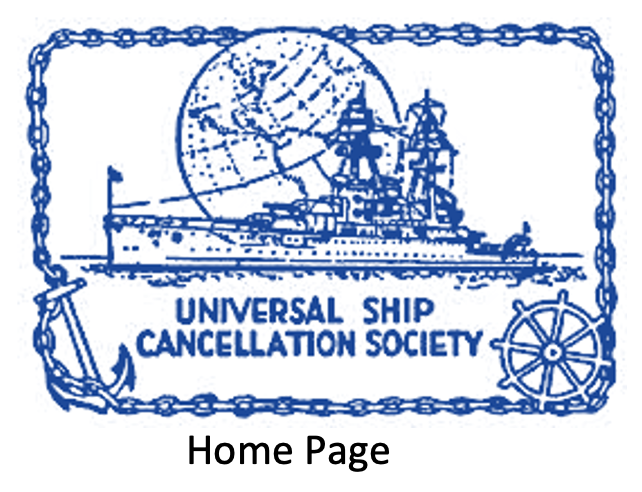Collecting Submarine Covers
by Ned Harris (USCS # 3608)
The U.S. Navy’s submarine force began with the 11 April 1900 sale of John P. Holland’s internal combustion, gasoline powered submarine, Holland VI, to the U.S. Navy for $160,000. The U.S.S. Holland, under command of Lieutenant Harry H. Caldwell, was placed in commission on 12 October 1900. Covers from these early submarines are hard to locate but picture post cards such as the one shown below are relatively easy to acquire.
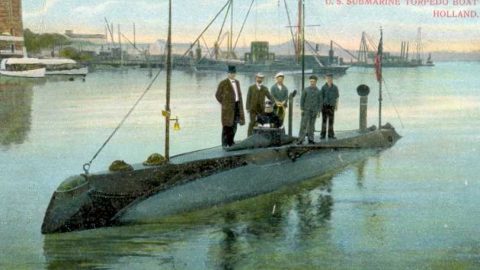
After Holland, the next seven submarines were characterized as A-boats. From 1903 to the early 1930s, the classes were designated alphabetically as A, B, C, D, E etc. Germany’s success with its U-boats in World War I resulted in the expedited development of the O and R class boats. This fiscal spurt ultimately lead to the S class submarines which became the mainstay force until the 1930s. Covers from the S class boats are relatively easy to acquire.
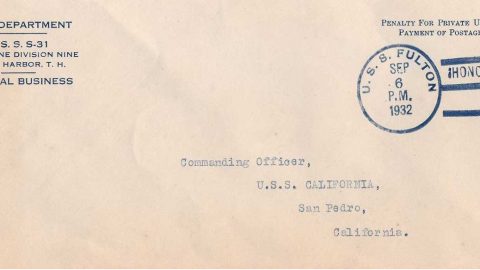
Starting about 1930, naval cover collectors began to apply decorative or event cachets to their covers and the practice quickly grew in popularity. Three key events for a new submarine are the Keel Laying, Launch and First Day in Commission. Collecting covers documenting these 3 events for each of the U.S. Navy submarines is very popular with collectors. Several cachet artists specialized in submarine covers and produced some exceptionally striking cachets.
Alex R. Hesse, of Brooklyn, New York, sponsored cachets over a 17-year period. For each of the Electric Boat events printed by Hesse, 100 were thermographed and then hand colored by he and his wife for VIPs and fellow members of the American Naval Cancellation Society (ANCS) Argonauts. He also printed covers for other naval cover sponsors including 185 different cachets for the ANCS Argonauts. The ANCS Argonauts covers are very popular and several collectors specialize in these covers.
Alex R. Hesse, of Brooklyn, New York, sponsored cachets over a 17-year period. For each of the Electric Boat events printed by Hesse, 100 were thermographed and then hand colored by he and his wife for VIPs and fellow members of the American Naval Cancellation Society (ANCS) Argonauts. He also printed covers for other naval cover sponsors including 185 different cachets for the ANCS Argonauts. The ANCS Argonauts covers are very popular and several collectors specialize in these covers.
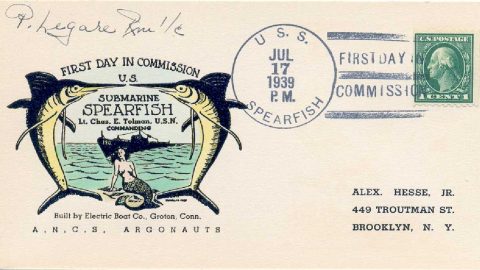
Gow C. Ng, of Portsmouth, New Hampshire, sponsored, serviced and drew cachets for a wide range of submarine events. Most of Ng’s cachets were hand drawn with colored inks and watercolors with the ship silhouette and/or namesake featured in the cachet. Ng frequently produced more than one design for an event. His covers are very striking and are quite popular with collectors. The USCS Cachet Makers Catalog contains a nearly complete checklist of Gow Ng cachets and is a valuable resource for naval cover collectors.
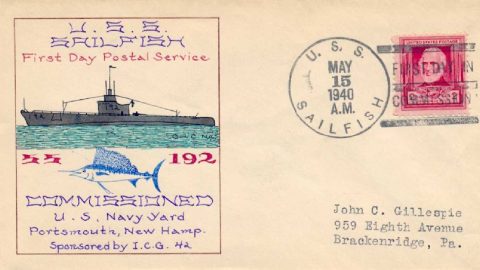
William F. Spader, of Noank, Connecticut, sponsored printed/photo/thermograph cachets for submarines built at Electric Boat Company in Groton, Connecticut.
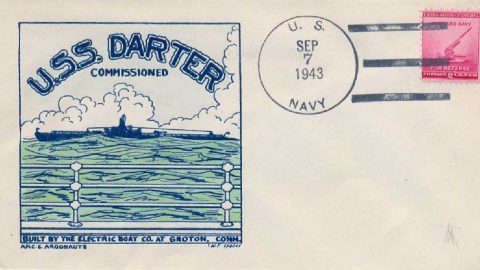
On 23 May 1938, USS Squalus (SS-192) submerged for a test dive off Portsmouth, New Hampshire and sank to the bottom due to flooding through a jammed main induction valve. A submarine marker buoy was released and word was passed through its telephone to her sister ship, USS Sculpin (SS-191), that there were survivors trapped on the bottom. Shortly after, the line parted and contact was lost. The next morning submarine rescue vessel U.S.S. Falcon arrived on the scene with the McCann Rescue Chamber aboard. With the help of Sculpin and other vessels, they were able to locate Squalus and the rescue started. A wire cable was attached to Squalus’s forward torpedo room by divers. The other end of this cable was fed to the downhaul reel in the McCann Rescue Chamber. The chamber was also attached to Falcon’s large salvage lift boom by another wire cable. A total of 4 trips were made down to Squalus. Finally, just past midnight on 25 May, thirty-nine hours after Squalus had sunk, the last of the 33 surviving crewmen reached the open air and the deck of Falcon. The rescue of the surviving Squalus crewmen was well documented by collectors. The cover below is one of several produced by Gow Ng for this event.
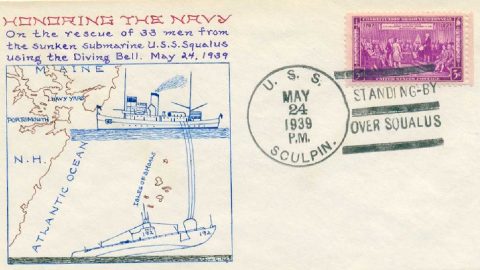
The December 7, 1941 Japanese attack on Pearl Harbor significantly degraded the U.S. Navy’s capability in the Pacific. It was the submarine force that was called upon to hold off the Japanese until the U.S. could recover. Admiral Chester W. Nimitz commended the job they did as follows: “It was to the submarine force that I looked to carry the load until our great industrial activity could produce the weapons we sorely needed to carry the war to the enemy. It is to the everlasting honor and glory of our submarine personnel that they never failed us in our days of great peril.”
The submarine force made an immense contribution to the war in the Pacific. They sank 1178 Japanese merchant ships totaling 5,053,491 tons plus 214 Japanese naval vessels totaling 577,625 tons.
The submarine service of the U.S. Navy suffered the highest percentage of losses of any branch of the American armed forces with almost one in five vessels failing to return. However, the achievements of the U.S. submarines are legend as their crews, while representing only two percent of the Naval personnel, accounted for over fifty five percent of Japanese shipping losses. The Japanese merchant marine was second to none and vital to the fighting potential and economy of the island nation, but by 1945 it had ceased to exist as the U.S. submarines succeeded in its near total destruction.
During World War II, “U.S. Navy” was used instead of the ship’s name in the postmark, as a wartime security measure. These postmarks are referred to a type-z cancels. Three distinct types of wartime submarine covers can be found. Construction event covers (Keel, Launch and FDC) with Type-z cancels, Sailor’s mail covers, i.e. personal mail from the ship’s crew, and lastly official “penalty mail” covers.
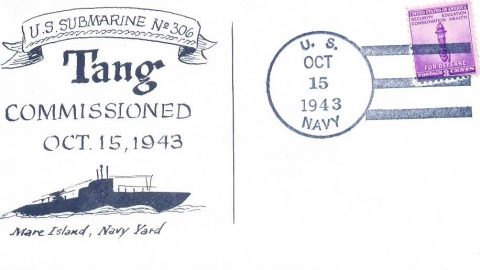

During World War II, 52 submarines out of a total of 288 were lost from various causes, and 374 officers and 3131 enlisted personnel were lost of the 16,500 that went on war patrols. Several USCS member specialize in collecting covers from these “sunk subs”.
The first nuclear submarine, U.S.S. Nautilus (SSN-571), was launched on 21 January 1954. The nuclear propulsion system, developed under the leadership of then Captain Hyman G. Rickover, was a major technological breakthrough and lead to today’s modern nuclear submarine force.
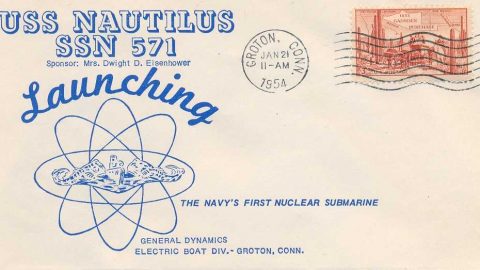
The first ballistic missile submarine, U.S.S. George Washington (SSBN-578) was launched on 9 July 1959. The Polaris missile system was developed in parallel under the leadership of Rear Admiral W. F. Raborn. On 20 July 1960 the first Polaris missile was successfully launched from the submerged U.S.S. George Washington off Cape Canaveral, Florida. Forty additional Polaris submarines were built and provided a key component to the nuclear deterrent triad. Collectors have well documented the key events associated with these “41 for Freedom” submarines including their missile test firings.
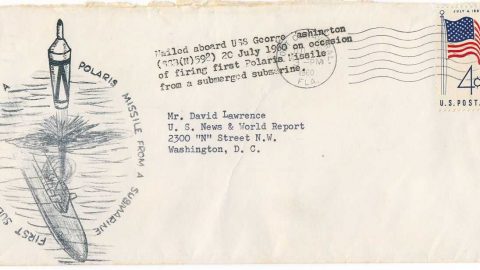
The U.S. nuclear submarines were also involved in several historic voyages that were well documented by their crews.
On 9 June 1958 Nautilus (SSN-571) departed Seattle, Washington on a classified mission designed to make a transit of the Arctic Ocean via the North Pole. On 19 June she entered the Chukchi Sea but was turned back by deep draft ice in these shallow waters. On the 28th she arrived at Pearl Harbor to await better ice conditions. By 23 July her wait was over and she set a course northward. She submerged in the Barrow Sea Valley on 1 August and on 3 August at 2315 (EDT) she became the first ship in history to reach the Geographic North Pole. From the North Pole, she continued on and after 96 hours and 1830 miles under ice, she surfaced NE of Greenland, having completed the first successful voyage across the North Pole. Approximately 1500 envelopes received the special cachet and 3 Aug 1958 North Pole postmark providing friends, relatives and selected VIPs with a wonderful souvenir of this historic voyage.
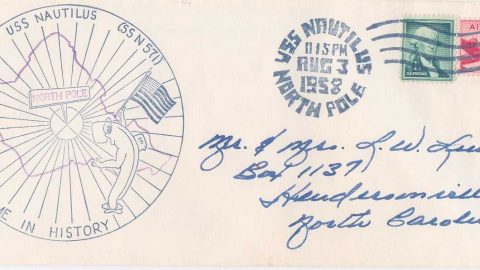
On March 17, 1959 the U.S.S. Skate (SSN-578), under the command of Commander James F. Calvert, became the first submarine to break through the ice and surface at the North Pole. It’s commemorative mail received a special one day cancel and cachet, creating one of the most elusive covers of submarine North Pole postal history (no collector mail is believed to have been carried on this classified trip).
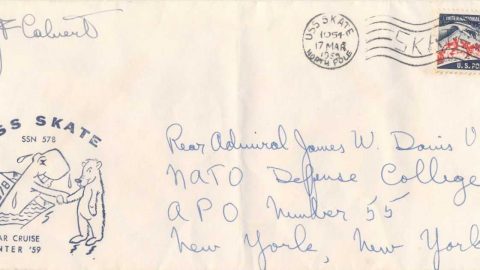
The U.S.S. Triton (SSN-586) was commissioned on 10 Nov 1959 under the command of Edward L. (Ned) Beach. Triton put to sea on her shakedown cruise on 15 Feb 1960, bound for the South Atlantic. She arrived in the middle Atlantic off St. Peter and St. Paul Rocks on 24 February to commence a history-making voyage. Having remained submerged since her departure from the east coast, Triton continued on south towards Cape Horn, rounded the tip of South America, and headed west across the Pacific. After transiting the Philippines and Indonesian archipelagoes and crossing the Indian Ocean, she rounded the Cape of Good Hope and arrived off St. Peter and St. Paul rocks on 10 April – 60 days and 21 hours after departing the mid-ocean landmark. She arrived back in Groton on 10 May, having completed the first submerged circumnavigation of the earth.
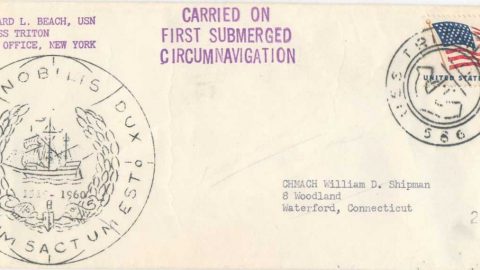
The history of the U.S. Navy’s submarine fleet is most interesting and collecting submarine covers is a great way to document their accomplishments.
A History of the Submarines Built at the Mare Island Naval Shipyard By Steve Shay
To view a list of United States submarines lost during World War 2:
Page 1 and Page 2 of Eternal Patrol Group of 52 Lost subs, data sheet #2
This list is page 1 and 2 of Data Sheet #2 published by the Universal Ship Cancellation Society. This data sheet also includes a list of U.S. submarine disasters during peacetime, a list of ships supporting Operation Crossroads as well as the target list, Operation Highjump information, Operation Inland Seas information and a list of battleships of the US Navy. This Data Sheet is available for sale from the Universal Cancellation Society.
